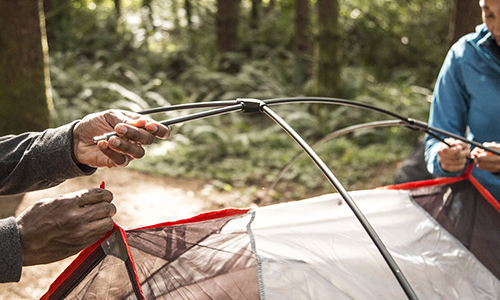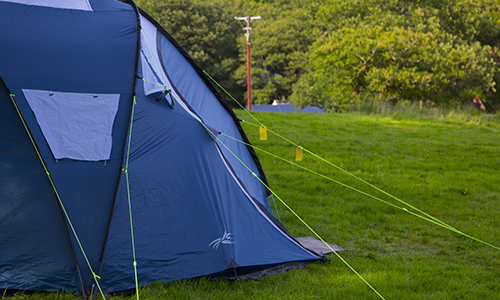DIY Tips for Setting up a Tent on a Camping Trip
Author

Chris shares his passion for cycling, hiking, skiing, and climbing from Buxton, in the Peak District. As a blogger for Outdoor Look, Chris shares outdoor tips and indoor tricks to help you get the most out of your time spent outside. When he's not out adventuring he's making videos or trying to keep up with his 4-year-old son.
 Spending time with nature and being in tandem with the surroundings can really help one cleanse the soul and take their mind off of their busy life. However, on adventure trips or secluded holiday trips, one should be well-equipped to sustain themselves in conditions where the resources are limited.
Spending time with nature and being in tandem with the surroundings can really help one cleanse the soul and take their mind off of their busy life. However, on adventure trips or secluded holiday trips, one should be well-equipped to sustain themselves in conditions where the resources are limited.
Nearly every tent, be it the same type, will be different in its design depending on the brand. Therefore, we will only focus on tents with fly sheet, poles that bend to form a tunnel and have an inner compartment.
Unpack the Tent
While unpacking, it is necessary that you are extra cautious with the tent as there are small components which can get lost or damaged. Also, in windy situations, make sure to keep something on the tent bag and tent fly, so that they don’t get blown away.
Separate the Components
Identify which part is the outer rain cover (tent fly) and which is the inner part of the tent. Get the stakes out of the bag and keep them ready before you take out the poles.
Start Joining the Poles
The poles have a stretchy string that internally links them, enabling them to be folded when not in use. Lay these poles after connecting them so that you can easily identify them.
Lay a Groundsheet
Some tents have a thin floor which is why it is necessary that you put a groundsheet on the place where you will set up your tent. This will give a protection from rough ground and will also act as a floor for your tent vestibule.
Attach the Poles to the Tent
 Some tunnel or dome tents have poles that connect to the inner fly and the outer is clipped afterwards. On the other hand there are tents where this system is followed in an opposite manner. The inner fly is clipped afterwards in some tents.
Some tunnel or dome tents have poles that connect to the inner fly and the outer is clipped afterwards. On the other hand there are tents where this system is followed in an opposite manner. The inner fly is clipped afterwards in some tents.
To properly connect the poles, one has to identify the right place for each pole to be connected. After identifying, bend each pole to fit them in the pole attachments. After all the poles are attached, make sure to clip the sides and top of the inner tent onto the poles.
Stake out the Corners of Your Tent
Secure all the corners to the ground with a peg or stake. Make sure that you eliminate all the slacks by pulling the corners before you place the stake. At an angle of 45°, put the stake in to the ground in a way that they lean away from the tent.
Attach the Outer Fly
To make sure that the door to the outer fly corresponds with the door to the inner tent, place the fly over the tent frame. Use the loops on the inside of the fly to secure it and attach the bottom corners of the fly either to an attachment, or to the ground with stakes.
Set up the Rest of the Tent
Once the fly is positioned correctly on top of the tent poles and inner tent, make sure the doors of the fly are zipped closed. Then you can stake out the rest of the loops on the bottom of the fly by gently drawing the fly away from the inner and creating tension between each stake.
Make sure that the tension across the whole of the fly is even. This will prevent the fly from flapping or touching the inner tent.
Make Sure to Secure the Guylines
Secure the guylines either to the ground or to the nearby trees or stones. Make sure that there is tension in the guylines as it will ensure better stability to the tent in windy situations. They also keep the tent fly away from the inner side and keep the insides of the tent protected from rain and wind.
Author

Chris shares his passion for cycling, hiking, skiing, and climbing from Buxton, in the Peak District. As a blogger for Outdoor Look, Chris shares outdoor tips and indoor tricks to help you get the most out of your time spent outside. When he's not out adventuring he's making videos or trying to keep up with his 4-year-old son.
- Speed Up Your Post-Hike Recovery with These 6 Essential Tips
- Cycling through Tranquil Roads and Coastal Views on the Isle of Wight
- The Essential Guide to Hiking Safety: 5 Tips Every Hiker Should Know
- Run Smart, Run Strong: Your Guide to Injury-Free Running
- Embrace Biking: Essential Tips for Beginners
Categories
- Sport (28)
- Product Reviews (3)
- Team Outdoor Look (7)
- Mike Wild (2)
- Mike Payton (2)
- Suse Hammond-Pears (3)
- Snowboarding (12)
- Latest Offers (105)
- Shop Talk (1)
- Competitions (7)
- Walking (413)
- Lifestyle Fashion (8)
- Travel (86)
- Kit Guides (176)
- Workwear Clothing (6)
- Safety Workwear (4)
- Health/Fitness (289)
- Skiing (91)
- Great Outdoors (1316)
- Cycling (92)
- January 2025
- December 2024
- November 2024
- October 2024
- September 2024
- August 2024
- July 2024
- June 2024
- May 2024
- April 2024
- March 2024
- February 2024
- January 2024
- December 2023
- November 2023
- October 2023
- September 2023
- August 2023
- July 2023
- June 2023
- May 2023
- April 2023
- March 2023
- February 2023
- January 2023
- December 2022
- November 2022
- October 2022
- September 2022
- August 2022
- July 2022
- June 2022
- May 2022
- April 2022
- March 2022
- February 2022
- January 2022
- December 2021
- November 2021
- October 2021
- September 2021
- August 2021
- July 2021
- June 2021
- May 2021
- April 2021
- March 2021
- February 2021
- January 2021
- December 2020
- November 2020
- October 2020
- September 2020
- August 2020
- July 2020
- June 2020
- May 2020
- April 2020
- March 2020
- February 2020
- January 2020
- December 2019
- November 2019
- October 2019
- September 2019
- August 2019
- July 2019
- June 2019
- May 2019
- April 2019
- March 2019
- February 2019
- January 2019
- December 2018
- November 2018
- October 2018
- September 2018
- August 2018
- July 2018
- June 2018
- May 2018
- April 2018
- March 2018
- February 2018
- January 2018
- December 2017
- November 2017
- October 2017
- September 2017
- August 2017
- July 2017
- June 2017
- May 2017
- April 2017
- March 2017
- February 2017
- January 2017
- December 2016
- November 2016
- October 2016
- September 2016
- August 2016
- July 2016
- June 2016
- May 2016
- April 2016
- March 2016
- February 2016
- January 2016
- December 2015
- November 2015
- October 2015
- September 2015
- August 2015
- July 2015
- June 2015
- May 2015
- April 2015
- March 2015
- February 2015
- January 2015
- December 2014
- November 2014
- October 2014
- September 2014
- August 2014
- July 2014
- June 2014
- May 2014
- April 2014
- March 2014
- February 2014
- January 2014
- December 2013
- November 2013
- October 2013
- September 2013
- August 2013
- July 2013
- June 2013
- May 2013
- April 2013
- March 2013
- February 2013
- January 2013
- December 2012
- November 2012
- October 2012
- September 2012
- August 2012
- July 2012
- June 2012
- May 2012
- April 2012
- March 2012
- February 2012
- January 2012
- December 2011
- November 2011
- October 2011
- September 2011
- August 2011
- May 2010
- April 2010
- March 2010
- February 2010
- January 2010
- November 2009
- October 2009
- September 2009
Submit a Comment